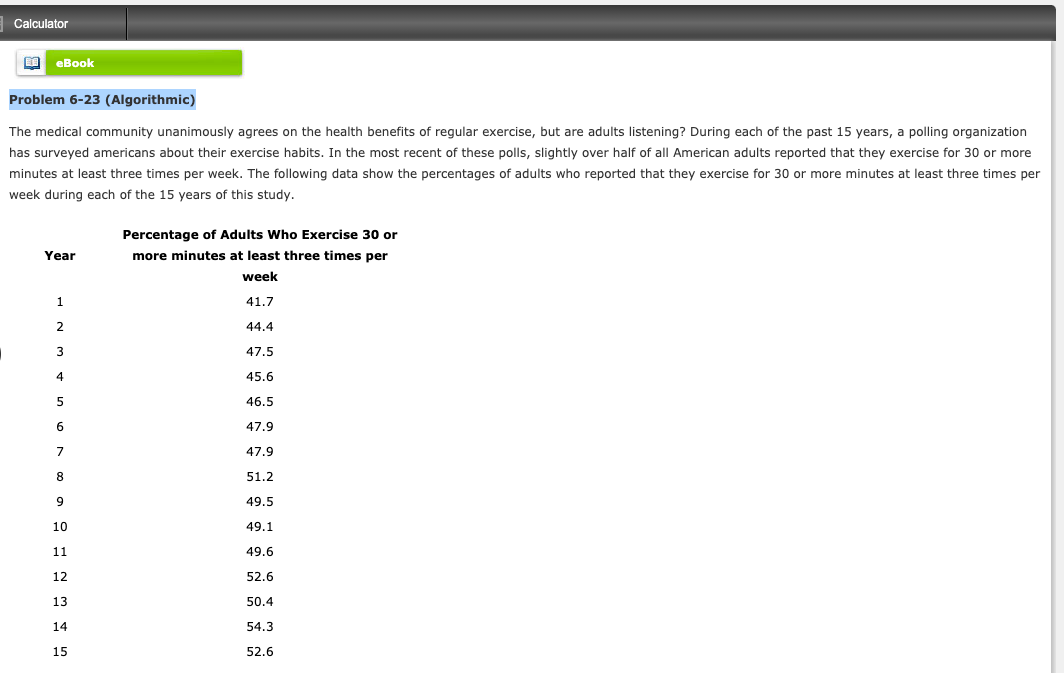Calculator eBook Problem 6-23 (Algorithmic) The medical community unanimously agrees on the health benefits of regular exercise, but are adults listening? During each of the past 15 years, a polling organization has surveyed americans about their exercise habits. In the most recent of these polls, slightly over half of all American adults reported that they exercise for 30 or more minutes at least three times per week. The following data show the percentages of adults who reported that they exercise for 30 or more minutes at least three times per week during each of the 15 years of this study. Percentage of Adults Who Exercise 30 or Year more minutes at least three times per week SDOYOUAWN 41.7 44.4 47.5 45.6 46.5 47.9 47.9 51.2 49.5 49.1 11 49.6 12 52.6 13 50.4 14 54.3 15 52.6a. Choose the correct time series plot. (i) 50 (ii) 60 Percent of Adults who Exercise 50 50 40 40 30 30 20 Percent of Adults who Exercise 20 10 10 0 2 4 6 10 12 14 16 2 4 6 10 12 14 16 Year (t) Year (t) (iii) 60 (iv) 50 Percent of Adults who Exercise 50 50 40 40 30 30 20 Percent of Adults who Exercise 20 10 0 2 4 6 10 12 14 16 2 4 6 10 12 14 16 Year (t) Year (t)Does a linear trend appear to be present? Possible Positive Linear Trend to find the parameters for the line that minimizes MSE for this time series. Do not round your interim computations and round your final ces. For subtractive or negative numbers use a minus sign. (Example: -300) Possible Negative Linear Trend No Trend Slope, b1 = MSE = c. Use the trend equation from part (b) to forecast the percentage of adults next year (year 16 of the study) who will report that they exercise for 30 or more minutes at least three times per week. Do not round your interim computations and round your final answers to four decimal places. For subtractive or negative numbers use a minus sign. (Example: -300) % d. Use the trend equation from part (b) to forecast the percentage of adults three years from now (year 18 of the study) who will report that they exercise for 30 or more minutes at least three times per week. Do not round your interim computations and round your final answers to four decimal places. For subtractive or negative numbers use a minus sign. (Example: -300) %Does a linear trend appear to be present? b. use simple linear regression to find the parameters for the line that minimizes MSE for this time series. Do not round your interim computations and round your final answers to four decimal places. For subtractive or negative numbers use a minus sign. (Example: -300) y-intercept, bo = Slope, b1 = MSE = c. Use the trend equation from part (b) to forecast the percentage of adults next year (year 16 of the study) who will report that they exercise for 30 or more minutes at least three times per week. Do not round your interim computations and round your final answers to four decimal places. For subtractive or negative numbers use a minus sign. (Example: -300) % d. Use the trend equation from part (b) to forecast the percentage of adults three years from now (year 18 of the study) who will report that they exercise for 30 or more minutes at least three times per week. Do not round your interim computations and round your final answers to four decimal places. For subtractive or negative numbers use a minus sign. (Example: -300) % Previous Next










